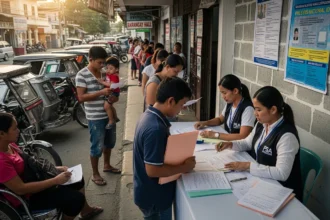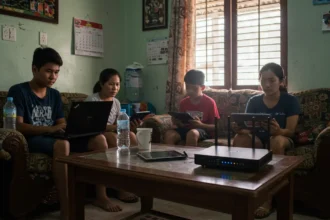From classrooms to offices to sari-sari stores, artificial intelligence (AI) tools are quietly changing how Filipinos live and work. The buzz around ChatGPT and Google Gemini has spread beyond tech circles and into ordinary households. For many Pinoys, these tools feel like science fiction becoming everyday reality.
- 📚 AI in Education: Helping Students and Teachers
- 🏢 AI in the Workplace: Productivity and Pressure
- 💼 AI and Small Business: Leveling the Playing Field
- 📊 Table 1: Common Uses of AI by Filipinos
- 🔍 Espionage or Efficiency? Fears Around AI Data Use
- 🌏 Lessons from Abroad: AI in Other Countries
- 📊 Table 2: AI Regulation Approaches Around the World
- ✅ Pros of AI Adoption in the Philippines
- ❌ Cons and Risks of AI Adoption
- ❓ Frequently Asked Questions (FAQ)
- ✨ Final Reflection: Pinoys, AI, and the Fight for Digital Relevance
- 🤖 References
But how exactly are Filipinos using AI? Are these tools making life easier, or raising new challenges in a country still catching up with digital infrastructure? This feature explores the real impact of AI tools in the Philippines – their opportunities, limitations, and what they might mean for the nation’s future.
📚 AI in Education: Helping Students and Teachers
Students across the Philippines are among the earliest adopters of AI tools. From generating summaries of long readings to helping with essays, ChatGPT has become a silent study buddy. Meanwhile, teachers have experimented with Gemini to create lesson plans or quiz questions faster.
Of course, this has sparked debate: does AI encourage learning, or does it promote laziness? Some schools have banned AI outright, fearing plagiarism, while others are cautiously testing it as an educational assistant. Regardless, the genie is out of the bottle – Filipino students are learning to navigate a new kind of classroom where AI is both a tool and a challenge.
🏢 AI in the Workplace: Productivity and Pressure
Offices in Manila, Cebu, and Davao are experimenting with AI to boost productivity. Marketing teams use AI to draft social media posts. Call centers use it for training scenarios. Even freelancers rely on AI for drafting proposals, editing graphics, or brainstorming ideas.
Yet this creates pressure: employees worry that AI might replace them, while managers hope AI will cut costs. For many workers, the challenge is not whether AI will take their job, but whether they can learn fast enough to use AI as part of their job. This balancing act defines much of the AI conversation in Philippine workplaces.
💼 AI and Small Business: Leveling the Playing Field
For small businesses, AI tools are a game-changer. A sari-sari store owner in Cavite can use ChatGPT to create marketing captions. A small café in Baguio can use Gemini to forecast sales trends based on customer data. What once required expensive consultants can now be done in minutes for free or at low cost.
This gives small enterprises a fighting chance against bigger corporations. By leveraging AI, they can look more professional, plan more strategically, and connect with customers more efficiently. The challenge, however, is whether these businesses can sustain AI use without reliable internet or digital literacy training.
📊 Table 1: Common Uses of AI by Filipinos
| Sector | AI Tool Usage Examples | Benefits |
|---|---|---|
| Education | Homework help, lesson planning, research summaries | Saves time, aids learning |
| Workplaces | Drafting emails, marketing content, data analysis | Improves productivity |
| Small Business | Social media posts, financial forecasting, captions | Cuts costs, boosts reach |
| Freelancers | Proposal drafting, portfolio editing, translation | Expands opportunities |
| Government (trial) | Chatbots, translation services | Faster citizen services |
🔍 Espionage or Efficiency? Fears Around AI Data Use
While many embrace AI, others worry about data privacy and misuse. ChatGPT and Gemini run on servers abroad, raising questions about how Filipino data might be used or stored. Concerns about surveillance, intellectual property theft, and bias in algorithms are valid and remain unresolved.
For ordinary Pinoys, this means being cautious. Using AI for sensitive documents, personal data, or confidential work could carry risks. It’s a reminder that while AI feels powerful, it’s still a foreign-controlled system, and Filipinos must remain vigilant about who really controls their digital lives.
🌏 Lessons from Abroad: AI in Other Countries
Filipinos aren’t alone in figuring out AI. In the U.S., students have sparked major debates about cheating with ChatGPT. In China, homegrown AI systems dominate the landscape. Meanwhile, Japan and South Korea have embraced AI in robotics and automation.
The Philippines can learn from these experiences: adopt AI carefully, regulate its risks, and ensure locals aren’t just consumers but creators. Without a national strategy, the country risks falling behind while relying too much on foreign AI platforms.
📊 Table 2: AI Regulation Approaches Around the World
| Country | AI Approach | Impact on Users |
|---|---|---|
| United States | Limited regulation, open use | Rapid adoption, plagiarism issues |
| China | Strong state control, homegrown AI | National AI dominance |
| EU | Strict AI Act with safety rules | User protection, slower rollout |
| Philippines | No formal AI law yet, cautious exploration | Growing adoption, uncertain risks |
✅ Pros of AI Adoption in the Philippines
- ✅ Boosts productivity for students and workers.
- ✅ Makes small businesses more competitive.
- ✅ Helps bridge skill gaps with free tools.
- ✅ Provides faster access to information.
- ✅ Encourages tech adoption and digital literacy.
❌ Cons and Risks of AI Adoption
- ❌ Data privacy concerns and lack of regulation.
- ❌ Risk of plagiarism in education.
- ❌ Over-reliance on foreign AI companies.
- ❌ Fear of job displacement.
- ❌ Unequal access due to poor internet in rural areas.
❓ Frequently Asked Questions (FAQ)
Q1: Is AI really being used widely in the Philippines?
Yes, adoption is growing fast. Students, office workers, and small business owners all report using AI tools like ChatGPT and Gemini for daily tasks. While not yet universal, awareness has surged in 2023–2024.
Q2: Are there Filipino-made AI tools?
Currently, most widely used tools are foreign-made. However, local startups and universities are beginning to experiment with AI projects. With government support, Filipino-made AI could become competitive in specific niches.
Q3: Can AI replace Filipino jobs?
AI can automate certain repetitive tasks, but it’s unlikely to replace jobs wholesale. Instead, it changes the skill sets required. Workers who learn to use AI as an assistant will remain valuable, while those who ignore it risk being left behind.
Q4: How safe is it to share personal data with AI?
Caution is necessary. AI systems store queries to improve performance, which means sensitive information may be at risk. Users should avoid entering confidential personal or business data into AI tools.
Q5: Is AI accessible in rural areas?
Internet connectivity remains the main barrier. While AI tools are free or low-cost, rural areas with poor connections struggle to access them effectively. This creates a “digital divide” in AI benefits.
Q6: Are schools in the Philippines banning AI?
Some schools discourage AI use for assignments, but many are beginning to explore AI as a teaching aid. DepEd and CHED have yet to release clear guidelines, leaving schools to set their own policies.
Q7: What are the benefits of AI for small businesses?
AI helps cut costs on marketing, accounting, and customer communication. Even small neighborhood shops can look professional with AI-generated posts or materials, leveling the field against bigger players.
Q8: Will the Philippines regulate AI soon?
Policymakers are discussing AI laws, but nothing formal has passed yet. With global discussions on AI regulation heating up, the Philippines will likely follow international trends within a few years.
Q9: How does AI affect creativity?
AI can spark ideas and accelerate creative work, but it risks homogenizing content if overused. Filipino artists and writers are learning to combine AI assistance with human originality.
Q10: Should Filipinos worry about AI bias?
Yes, bias in AI outputs reflects biases in the data they were trained on. Filipinos should be critical users, questioning outputs instead of accepting them blindly.
✨ Final Reflection: Pinoys, AI, and the Fight for Digital Relevance
The rise of AI in the Philippines is not just about convenience or curiosity – it’s a matter of national competitiveness. Whether in classrooms, workplaces, or sari-sari stores, AI is shaping how Filipinos learn, work, and compete globally. For now, these tools are largely foreign-made, raising urgent questions about sovereignty, privacy, and long-term dependence.
But the story doesn’t have to end there. Filipinos have a history of adapting quickly to new technologies, from texting in the early 2000s to dominating social media in the 2010s. With the right balance of regulation, education, and innovation, the Philippines could transition from being passive consumers of AI to active creators of AI solutions tailored for Filipino needs.
The challenge is to avoid being left behind. If AI becomes the global language of productivity and progress, then Filipinos must learn to speak it fluently – not as copycats, but as innovators. Otherwise, the country risks becoming just another testing ground for foreign tech giants, instead of a leader in Southeast Asia’s digital revolution.
In the end, the question is not whether AI will shape the Philippines. The question is whether Filipinos will shape AI to serve their people, their values, and their future. The rise of AI tools offers opportunity, but only if embraced wisely, critically, and with the same resilience that defines the Filipino spirit.
🤖 References
-
Philstar – Pinoys top ChatGPT users worldwide
-
Sprout PH – The 35+ Best Free AI Tools for Business Growth
-
BusinessWorld – More Filipino students now using AI for learning
-
Newsbytes PH – PH ranks among top global Internet and AI users: report
-
Truelogic – Adoption of AI in the Philippines
-
Facebook PHROA Group – Philippines leads in ChatGPT usage and responsible AI use










